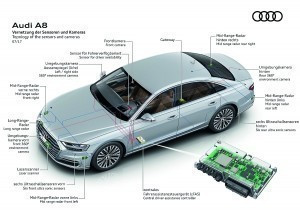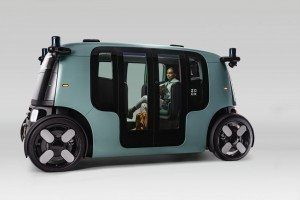Innovation leadership for AI is at stake:Dynamic distance radar or parking, braking and lane departure warning systems are installed in many mid-range cars today. They belong to level 2 (partially automated driving) in the gradation of automotive automation(Fig. 1). At this level, automated driving on highways or expressways is certainly possible, but the driver's hands may only leave the steering wheel for a few seconds. In the extended version, it is also possible to change lanes automatically by activating the blinker. The driver no longer has to permanently monitor the system, but must take over the steering wheel again within 10 seconds.
Audi also installed a laser scanner (LIDAR) from Valeo in the new A8 back in 2017. The central driver assistance control unit (zFAS) combines the entire sensor system(Fig. 2) and thus enables highly automated level 3 driving. Fig. 2: Audi A8 assistance systems from 07/17 including Valeo LIDAR, Light Detection and Ranging
Fig. 2: Audi A8 assistance systems from 07/17 including Valeo LIDAR, Light Detection and Ranging
The tragedy was that the legal regulations were not yet in place. Technically possible since 2017, but practically not permitted (see also PLUS 10-2019), which is why Audi was unable to activate the function. The manufacturer has therefore currently put its SAE Level 3 activities on hold.
Since 22.01.2021: Level 3 release
In June 2020, the United Nations Economic Commission for Europe (UNECE) updated the technical regulations for road traffic. This means that highly automated driving (Level 3) has been possible since January 22, 2021 - but currently only up to a speed of 60 km/h. This is a downer, as level 3 systems are practically only highly automated traffic jam assistants. The speed limit is to be raised gradually.
Level 3 vehicles are being launched by Mercedes (S-Class W 223), BMW (iX electric model), Audi (A8) and also Tesla (Full Self Driving/FSD). Large TIER 1 suppliers such as Continental supply the systems. While the equipment for a Level 2 vehicle costs €200 to purchase, the equipment for a Level 3 car costs ≥ €2000.
New S-Class Level 3 capable
While Audi has put its system on hold, Mercedes is consistently pursuing Level 3 capability with the new W 223 S-Class model. The following systems are installed for this purpose:
- Multimode radar
- Multipurpose stereo camera
- Laser scanner (LIDAR)
- Cameras for monitoring the driver
- HD maps (high-resolution maps of the federal highways)
- Camera for rear traffic
- Microphones for detecting emergency vehicles with horns
Vehicles that have already been delivered will be approved 'over the air' - a method that has long been standard at Tesla. In addition to UNECE approval, German car manufacturers require approval from the Federal Motor Transport Authority. Transport Minister Andreas Scheuer is planning a federal law for 2022 in which the rules for autonomous driving are to be laid down. Fig. 3: Mercedes S-Class W 223 for highly automated driving at level 3 (Image: Mercedes)
Fig. 3: Mercedes S-Class W 223 for highly automated driving at level 3 (Image: Mercedes)
In a nutshell:
- The United Nations Economic Commission for Europe (UNECE) adopted the technical rules for highly automated driving in June 2020. From January 22, 2021, driving according to SAE Level 3 will be possible
- Audi had already installed the necessary sensor technology for highly automated driving in accordance with Level 3 in the new A8 at the end of 2017. Unfortunately, the project was put on hold due to a lack of legal regulation and therefore approval from the Federal Motor Transport Authority
- The laser scanner (LIDAR) required for this came from the French TIER 1 supplier Valeo (see PLUS 11-2019, LIDAR for passenger cars a growth market of the future)
- In its new S-Class, Mercedes has laid the foundations in terms of technology and software for highly automated driving level 3. A microphone system for special signals (siren) is also installed to make way for automated emergency vehicles
"We want to create a legal framework for autonomous driving that guarantees data protection and data security as well as the highest level of safety," reads page 48 of the coalition agreement from spring 2018. Andreas Scheuer wanted to deliver the law at the beginning of 2019. The first draft was distributed at the end of 2020, almost two years late. Whether this law will be passed before the end of the legislative period in June is more than questionable.
In the USA, Waymo has received $3 billion in further funding and will soon be deploying robotaxis in Phoenix/Arizona without safety drivers once the test period is complete. The first autonomous vehicles from GM subsidiary Cruise are already in operation in San Francisco. Amazon wants autonomous delivery vehicles in the future and is buying Zoox(Fig. 4) for $1 billion. Nuro is also receiving $1 billion in venture capital to develop faster delivery robots. Fig. 4: Amazon's robotaxi from Zoox with combined camera, radar and LIDAR sensor technology (Image: Zoox)
Fig. 4: Amazon's robotaxi from Zoox with combined camera, radar and LIDAR sensor technology (Image: Zoox)
Didi' and 'Pony' are active in China with investment budgets of several hundred million dollars. Baidu's robot cab service called 'Apollo Go' is even bigger.
Anyone who describes autonomous vehicles as a technical gimmick does not understand the future potential. Behind this is nothing more or nothing less than the innovation leadership for artificial intelligence and thus the future of the German automotive industry and the world's largest suppliers such as Bosch, Continental or ZF.
Therefore, Minister Scheuer, deliver a law for autonomous driving!
I wish you an optimistic start to the spring, despite the continuing adversity
Yours
Hans-Joachim Friedrichkeit
contact


